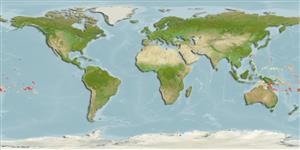>
Gobiiformes (Gobies) >
Gobiidae (Gobies) > Gobiinae
Etymology: Priolepis: Greek, prio = to saw + Greek,lepis = scale (Ref. 45335); triops: Name from the Greek tri, three, and ops, eye, in reference to the third 'eye' formed by the characteristic ocellated black spot in the first dorsal fin of the new species; noun in apposition..
More on authors: Winterbottom & Burridge.
Environment: milieu / climate zone / depth range / distribution range
Ecología
marino asociado a arrecife; rango de profundidad 15 - 24 m (Ref. 58018). Tropical
Pacific Ocean: Fiji and the Society Islands. Recently recorded from Tonga (Ref. 53797).
Tamaño / Peso / Age
Maturity: Lm ? range ? - ? cm
Short description
Claves de identificación | Morfología | Morfometría
Espinas dorsales (total) : 7; Radios blandos dorsales (total) : 11; Espinas anales: 1; Radios blandos anales: 9. Large ocellated black spot in the first dorsal fin at all growth stages. Banded color pattern consisting of narrow grey bars on a yellow background. Lacks opercular scales at all sizes, and tends to have fewer lateral, transverse, and predorsal scales than either P. cinctus or P. squamogena.
Life cycle and mating behavior
Maturities | Reproducción | Spawnings | Egg(s) | Fecundities | Larva
Winterbottom, R. and M. Burridge, 1993. Revision of Indo-Pacific Priolepis species possessing a reduced transverse pattern of cheek papillae, and predorsal scales (Teleostei: Gobiidae). Can. J. Zool. 71:2056-2076. (Ref. 10753)
IUCN Red List Status (Ref. 130435)
Threat to humans
Harmless
Human uses
Herramientas
Special reports
Download XML
Fuentes de Internet
Estimates based on models
Preferred temperature (Ref.
123201): 26 - 27.8, mean 26.4 °C (based on 24 cells).
Phylogenetic diversity index (Ref.
82804): PD
50 = 0.5000 [Uniqueness, from 0.5 = low to 2.0 = high].
Bayesian length-weight: a=0.01023 (0.00477 - 0.02194), b=3.02 (2.84 - 3.20), in cm total length, based on LWR estimates for this (Sub)family-body shape (Ref.
93245).
Nivel trófico (Ref.
69278): 3.2 ±0.3 se; based on size and trophs of closest relatives
Resiliencia (Ref.
120179): Alto, población duplicada en un tiempo mínimo inferior a 15 meses (Preliminary K or Fecundity.).
Fishing Vulnerability (Ref.
59153): Low vulnerability (10 of 100).
